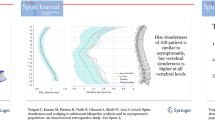Abstract
Study Design
Retrospective observational study.
Objectives
To determine the mass distribution along the scoliotic trunk using barycentremetry and its relationship with vertebral axial rotation and torque.
Summary of the Background Data
Deformity progression in adolescent idiopathic scoliosis (AIS) is not yet fully understood, but gravity load on the spine could play a role. Barycentremetry allows to characterize body mass distribution in standing position, which could provide a better understanding the mechanisms of progression.
Methods
81 subjects (27 healthy adolescents and 53 AIS patients) underwent biplanar radiography and 3D reconstruction of the spine and body envelope. Position of the gravity line was estimated, as well as trunk segmental centers of mass COMs at each vertebral level and resulting axial torques to each vertebra.
Results
The COM of all trunk segments was less than 1 cm from the gravity line in the frontal plane for healthy subjects, and less than 1.5 cm for AIS patients. Vertebral axial torque was 0.7 ± 0.5 Nm in healthy subjects, 2.9 ± 2.1 Nm at the junctional vertebrae of AIS patients and 0.5 ± 0.5 at the apex. A strong association was found between high torque and high intervertebral rotation at junctions, with low torque and low intervertebral axial rotation at the apex.
Conclusion
Results suggest that AIS patients can maintain the COM of each body segment close to their gravity line, irrespective of the severity and asymmetry of their deformity. Moreover, torque analysis shed some light on the importance of junctional vertebrae in the spinal deformity and, potentially, in the vicious cycle determining scoliosis progression.
Level of Evidence
Level III.
Similar content being viewed by others
References
Skalli W, Vergari C, Ebermeyer E, et al. Early detection of progressive adolescent idiopathic scoliosis: a severity index. Spine 2017;42:823–30.
Stokes IA, Spence H, Aronsson DD, Kilmer N. Mechanical modulation of vertebral body growth. Implications for scoliosis progression. Spine 1996;21:1162–7.
Duval-Beaupère G, Robain G. Visualization on full spine radiographs of the anatomical connections of the centres of the segmental body mass supported by each vertebra and measured in vivo. Int Orthop 1987;11:261–9.
Amabile C, Nérot A, Choisne J, et al. Alignment of centers of mass of body segments with the gravity line. Comput Methods Biomech Biomed Engin 2015;3:111.
Schwab F, Lafage V, Boyce R, et al. Gravity line analysis in adult volunteers: age-related correlation with spinal parameters, pelvic parameters, and foot position. Spine 2006;31:E959–67.
Steffen JS, Obeid I, Aurouer N, et al. 3D postural balance with regard to gravity line: an evaluation in the transversal plane on 93 patients and 23 asymptomatic volunteers. Eur Spine J 2010;19:760–7.
Adam CJ, Askin GN, Pearcy MJ. Gravity-induced torque and intra-vertebral rotation in idiopathic scoliosis. Spine 2008;33:E30–7.
Keenan BE, Pettet GJ, Izatt MT, et al. Gravity-induced coronal plane joint moments in adolescent idiopathic scoliosis. Scoliosis 2015; 10:35.
Nérot A, Choisne J, Amabile C, et al. A 3D reconstruction method of the body envelope from biplanar x-rays: evaluation of its accuracy and reliability. J Biomech 2015;48:4322–6.
Hernandez T, Vergari C, Thenard T, et al. Coronal trunk imbalance in idiopathic scoliosis: Does gravity line localisation confirm the physical findings? Rev Chir Orthop Traumatol 2018:442–8.
Aubert B, Vergari C, Ilharreborde B, et al. 3D reconstruction of rib cage geometry from biplanar radiographs using a statistical parametric model approach. Comput Methods Biomech Biomed Eng Imaging Vis 2016;4:281–95.
Humbert L, De Guise JA, Aubert B, et al. 3D reconstruction of the spine from biplanar X-rays using parametric models based on transversal and longitudinal inferences. Med Eng Phys 2009;31:681–7.
Dempster WT. Space requirements of the seated operator: geometrical, kinematic, and mechanical aspects of the body with special reference to the limbs. Wright-Patterson Air Force Base. OH: Wright Air Development Center; 1955.
Amabile C, Choisne J, Nérot A, et al. Determination of a new uniform thorax density representative of the living population from 3D external body shape modeling. J Biomech 2016;49:1162–9.
Stokes IA. Three-dimensional terminology of spinal deformity. A report presented to the Scoliosis Research Society by the Scoliosis Research Society Working Group on 3-D terminology of spinal deformity. Spine 1994;19:236–48.
Langlais T, Vergari C, Pietton R, et al. Shear-wave elastography can evaluate annulus fibrosus alteration in adolescent scoliosis. Eur Radiol 2018;28:2830–7.
Author information
Authors and Affiliations
Corresponding author
Additional information
Author disclosures: TT (none), CV (none), TH (none), RV (grants from Eos Imaging, other from Spineguard, other from Stryker Spine, other from NuVasive, outside the submitted work), WS (coinventor of the EOS system, without personal financial benefit [royalties rewarded for nonprofit research and education institutions]).
IRB approval: Subject inclusion was approved by the ethical committee (6001 CPP Ile de France VI and local hospital ethical committee).
Funding: The authors are grateful to the ParisTech BiomecAM chair program on subject-specific musculoskeletal modelling (with the support of ParisTech and Yves Cotrel Foundations, Société Générale, Proteor and Covea)
Rights and permissions
About this article
Cite this article
Thenard, T., Vergari, C., Hernandez, T. et al. Analysis of Center of Mass and Gravity-Induced Vertebral Axial Torque on the Scoliotic Spine by Barycentremetry. Spine Deform 7, 525–532 (2019). https://doi.org/10.1016/j.jspd.2018.11.007
Received:
Revised:
Accepted:
Published:
Issue Date:
DOI: https://doi.org/10.1016/j.jspd.2018.11.007




